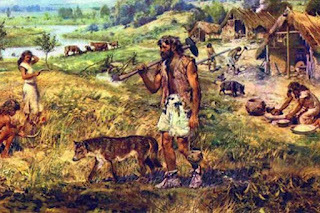#StoneAgeInnovation
Text
The Neolithic

The term Neolithic, derived from the Greek words "neo" (new) and "lithos" (stone), indicates the era in which humanity perfected the art of working stone, giving it a smooth surface. This phase began approximately 8,000 years ago and concluded about 5,000 years ago.
Transformation Engines: Agriculture and Animal Husbandry
The transition from the Paleolithic to the Neolithic was primarily driven by the discovery of agriculture and animal husbandry. These two pillars transformed humans from nomads to sedentary beings, marking the beginning of community life.
Mesolithic: The Transitional Age
The Mesolithic, known as the middle stone age, served as a bridge between the Paleolithic and the Neolithic, characterized by a gradual shift in human lifestyles.
Neolithic Architecture: From Huts to Stilt Houses
While in the Paleolithic, dwellings consisted of caves and rudimentary huts, the Neolithic witnessed the construction of the first structured houses. Houses, made with wooden beams and clay and straw bricks, featured a single large central room, often equipped with a hearth.
Over time, to defend against enemies and fierce animals, humans developed stilt houses, huts built on stilts driven into lakes or marshes, connected to the mainland by walkways.
Neolithic Village Organization: From Field to Community
Neolithic villages were located near watercourses and included houses, ovens, granaries, and other essential elements. Village inhabitants specialized in specific tasks, with women dedicated to weaving and leatherworking, while men engaged in agriculture and animal husbandry.
Social Structure: Clans, Tribes, and Communities
Families within the village formed clans, each with an elder as its leader. Decisions involving the entire village were made by gathering the heads of families. The need to live in groups led to the creation of shared rules, giving rise to cohesive communities with common language, habits, and rules.
Exploring New Horizons: Art, Trade, and Spirituality
With the development of agriculture and animal husbandry, the Neolithic human perfected the art of working stone and metals, giving rise to advanced tools. Ceramics, craftsmanship, and early forms of trade flourished, paving the way for new artistic expressions and the construction of monuments dedicated to divine worship.
In conclusion, the Neolithic is not just the era of new stone but represents a crucial chapter in human history, marked by the transformation of lifestyles and the emergence of complex societies.
#NeolithicEra#StoneAgeInnovation#AncientArchitecture#VillageLife#HumanTransformation#CommunityBuilding#AncientSocieties#CulturalEvolution#NeolithicArt#TradeHistory#SpiritualHeritage#HistoricalInnovations#ArchaeologicalDiscoveries#AncientCraftsmanship#SocialStructures#NeolithicCulture#HistoricalDevelopment#CulturalExpression#SedentaryLiving#AncientHistory
0 notes